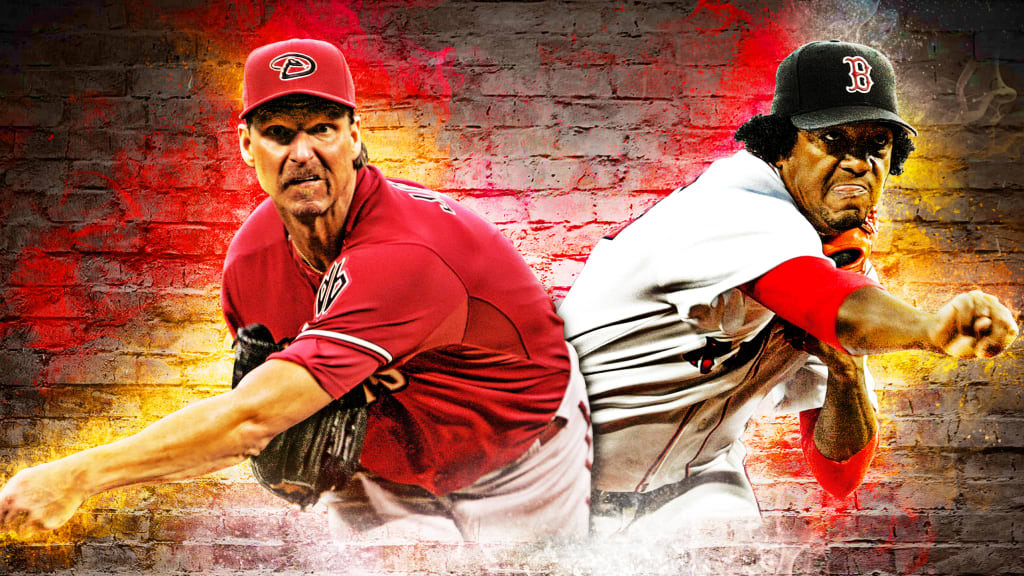
There were many great starting pitchers in the late 1990s and early 2000s. Think Greg Maddux, Tom Glavine, Mike Mussina, Roy Halladay, all Hall of Famers. Then Roger Clemens, Curt Schilling and the list goes on. But no one was better at the turn of the century than Randy Johnson and Pedro Martinez.
From 1994-2009, the years both were active as full-time starters, Johnson and Martinez were the top two in Baseball Reference wins above replacement (WAR), adjusted earned run average (ERA+) and strikeouts. And it isn't very close. They can be counted not only as the elite starters of their era, but elite starters for the ages, each blowing hitters away with blazing fastballs and an assortment of devastating secondary offerings.
Their similarities and differences are striking. Each spent some of his early seasons with the Expos, and each brought his career to a close in 2009. One strikeout machine was in the American League during his peak years and the other was in the National League. Both went into the Hall of Fame as part of the Class of 2015. One is 6 feet, 10 inches tall and the other is 5 feet, 11 inches tall.
The question is: If you could have only one of these two leading your starting rotation during the years both were pitching, who would it be?
While there's no perfect method to definitively answer that question, we're going to analyze their careers and let you come to your own conclusion (a tall order, we know).
First, a look at each magnificent hurler individually.
Randy Johnson
The Big Unit. Those three words conjure up visions of 100 mph fastballs and devastating sliders from a left-hander who looked like he was 20 feet tall on the mound. He was actually 6 feet, 10 inches tall, but the intimidation factor was probably on par with Bob Gibson.
Johnson was drafted by the Expos and made his big league debut with Montreal in 1988. He was wild, making his heater even more worrisome for batters, particularly those who were left-handed. The Expos traded him to the Mariners in May of 1989, and his control issues persisted -- Johnson led the Majors in walks every year from 1990-92. But then he had a talk with the great Nolan Ryan, who also had control issues in his early days. Suddenly, Johnson became almost unhittable.
Johnson had shown flashes of brilliance before -- he no-hit the Tigers at the Kingdome on June 2, 1990, and was already racking up the strikeouts alongside the walks. But the switch had been flipped and Johnson became overpowering.
From 1995-2002, from age 31 through 38, the Big Unit won five Cy Young Awards, including four in a row from 1999-2002 with the D-backs. In '01, he tied a Major League record for strikeouts in a nine-inning game by fanning 20 against the Reds on May 8. That fall, he helped Arizona win its first World Series title, being named co-MVP of the Series against the Yankees along with rotation mate Schilling.
Johnson's 1990 no-hitter wasn't his last -- he threw a perfect game for Arizona against the Braves on May 18, 2004. When it was all said and done, Johnson finished with 4,875 strikeouts, the most by a left-hander in MLB history and trailing only Ryan's 5,714 for the most by any pitcher.
Pedro Martinez
From 1999-2003, Martinez was so dominant that he may have created the largest gap between a starting pitcher's performance and the rest of the league that we've ever seen. His ERA+ over those five seasons was an unbelievable 228, and in one of those years, 2000, Martinez set an MLB record for qualified starters by finishing with a 291 ERA+. Oh, and all of this happened in the highest run-scoring environment in baseball history. In fact, in 2000, the season Martinez was at his pinnacle, more runs were scored than in any other season in MLB history.
But wait, there's more: Martinez not only won back-to-back Cy Young Awards with the Red Sox in 1999 and 2000, he had won one before that, in 1997 with the Expos. That year, he had an MLB-best 1.90 ERA (he would lead the Majors in ERA five times in his career) over 31 starts and also led baseball with 13 complete games. Martinez struck out 32 percent of batters he faced in '97, and 36 percent at his peak from 1999-2000. In '99, he had a streak of eight consecutive starts from Aug. 19 to Sept. 27 during which he struck out 11 or more batters, with a high of 17 at Yankee Stadium on Sept. 10.
Martinez was an eight-time All-Star, with his shining moment coming on his home mound at Fenway Park in 1999. In a performance reminiscent of Carl Hubbell in the 1934 Midsummer Classic, Martinez struck out the first four batters he faced -- Barry Larkin, Larry Walker, Sammy Sosa and Mark McGwire. The first two are Hall of Famers and the last two combined to hit 136 homers the prior year. Overall, Martinez struck out five in two innings, getting Jeff Bagwell (another Hall of Famer) swinging in the second inning. Martinez was named All-Star Game MVP.
If all of that wasn't enough, Martinez helped lead Boston to its first World Series title in 86 years when the Red Sox overcame a 3-0 AL Championship Series deficit to the Yankees before sweeping the Cardinals in the Fall Classic.
Who's it going to be?
Now comes the hard part. How can you possibly choose only one from this legendary duo? Let's compare and let you decide.
A note: Since Martinez only made two appearances in 1992 and was primarily a reliever in '93, we're excluding those years from the calculus here.
As we stated, there's no perfect formula to determine which of these pitchers was the best in the years they were both active. But we'll focus on six key stats here: Baseball Reference wins above replacement (WAR), WAR per 200 innings, seven-year peak WAR, adjusted earned run average (ERA+), strikeout percentage and average innings pitched per season.
WAR gives us an all-around measurement of how well a pitcher performed. WAR/200 innings shows how much value he averaged per approximately one healthy season during this era. The seven-year peak WAR gives us an idea of how valuable the pitcher was at his absolute best.
ERA+ gives us a park- and league-adjusted figure to show how much better he was than the average pitcher. Strikeout percentage tells us what percentage of batters he faced went down on strikes. The reason we include average innings pitched per season is because that gives us an idea of how healthy and available the pitcher was for his club.
Since individual awards and postseason success depend heavily on factors outside a single player’s control -- the competition, the quality of the team around him, etc. -- that won’t factor into the analysis here. But we have included some notable achievements to help you further appreciate each pitcher's greatness.
So let's get into it.
Johnson, 1994-2009
WAR: 89.3
WAR/200 IP: 5.8
7-year peak WAR: 53.9 (1999-2005)
ERA+: 147
K%: 30%
Avg. IP per season: 191
Accolades: Five-time Cy Young Award winner, eight-time All-Star, 2001 World Series Co-MVP, Hall of Fame Class of 2015
Martinez, 1994-2009
WAR: 82.8
WAR/200 IP: 6.1
7-year peak WAR: 57.3 (1997-2003)
ERA+: 154
K%: 28%
Avg. IP per season: 170
Accolades: Three-time Cy Young Award winner, eight-time All-Star, 1999 All-Star Game MVP, 2004 World Series champion, Hall of Fame Class of 2015
Wow. Considering we're looking at a 16-year period here, these numbers are not only incredible, they are incredibly close.
If total value and durability are important to you, Johnson's your man, leading Martinez in total WAR and innings pitched per season. But if you want the most bang for your buck, Martinez had the higher WAR/200 innings pitched and ERA+. He also had a slightly better peak than Johnson did. If strikeout rate is your thing, the Big Unit edges Pedro.
So there you have it. Who ya got?
